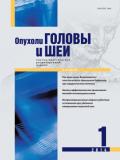Vol 4, No 1 (2014)
- Year: 2014
- Published: 15.04.2014
- Articles: 10
- URL: https://ogsh.abvpress.ru/jour/issue/view/2
Full Issue
DIAGNOSIS AND TREATMENT OF HEAD AND NECK TUMORS
NASAL SKIN CANCER. POSSIBILITIES OF PLASTIC REPLACEMENT OF THE DEFECT DURING SURGICAL TREATMENT
Abstract
The article is determined to the analysis of different types of plastic reconstruction of the external nose with local and combine flaps after radical surgery in oncology. Reconstruction of the external nose is discussed under consideration of experience of our research center, which includes surgical treatment of 35 oncologic patients.
 4-10
4-10


USE OF PREDICTORS TO CHOOSE TREATMENT POLICY FOR THYROID CANCER
Abstract
 11-14
11-14


ANALYSIS OF THE EFFICIENCY OF CRYOGENIC TREATMENT FOR TONGUE CANCER
Abstract
 15-23
15-23


TREATMENT OPTIONS FOR LOCOREGIONAL RECURRENCES OF ORAL AND OROPHARYNGEAL MUCOSAL SQUAMOUS CELL CARCINOMA
Abstract
The study included 314 patients with recurrent squamous cell carcinoma of the oral cavity and oropharynx after radical treatment. Patients were divided into groups depending on the timing – patients with early recurrence (n = 162), and late recurrence (n = 152 ), and depending on the type of treatment of recurrent tumors: conservative treatment group (n = 56 ), surgical (n = 235) and combined treatment (n = 23) group. A comparative evaluation of the effectiveness of the treatment of these patients based on the results of treatment, survival rates, the frequency and severity of complications. The conservative therapy of recurrent tumors of the oral cavity if surgical treatment is impossible is effective, especially in cases of late recurrent tumors but only surgical or combined treatment may reach the five-year survival rate in patients with recurrent tumor, cancer of the oral cavity and oropharynx.
 24-29
24-29


REVIEWS
 30-37
30-37


ORIGINAL REPORTS
RESULTS OF CONCOMITANT PHOTON-NEUTRON THERAPY IN THE PALLIATIVE TREATMENT OF METASTATIC BRAIN TUMORS ACCORDING TO THE DATA OF THE CHELYABINSK REGIONAL CLINICAL ONCOLOGY DISPENSARY
Abstract
 38-42
38-42


CASE REPORTS
THE OPTION OF USING THE PARAMEDIAN FOREHEAD FLAP TO ELIMINATE DEFORMATIONS OF THE EXTERNAL NOSE AFTER TREATMENT OF CANCER (CLINICAL OBSERVATION)
Abstract
 43-46
43-46


 47-49
47-49


MUST ONCOLOGICAL PRINCIPLES BE IN THE SURGERY OF MENINGIOMAS? EN BLOC REMOVAL OF GIANT RIGHT FRONTAL MENINGIOMA WITH EXTRACRANIAL SPREAD. DESCRIPTION OF A CLINICAL CASE
Abstract
The use of the oncological principle – en bloc ablastic tumor resection – can expect a breakthrough in the treatment of baseline unfavorable patient groups. In the described case of atypical meningioma, its en bloc resection presents significant technical difficulties when accomplishing the task associated with the giant sizes of a tumor as an iceberg growing outside and into the cranial cavity, its rich vascularization from both the internal and external carotid artery system, with the involvement of the superior sagittal sinus, the presence of a dense bone crown that combines the three-component construction of a neoplasm, which made difficult safe mobilization and scanning in the cranial cavity.
In such topographic variants, the criteria for the Simpson radical meningioma resection are inapplicable and only en bloc tumor resection may reflect the oncological principles of surgery. The technologies of en bloc resection of intracranial meningiomas should be more frequently used because preoperative neurovisualization and even histological diagnosis does not always allow the grade of meningiomas to be specified. 50-54
50-54


ПРЕСС-РЕЛИЗ
 55-56
55-56












